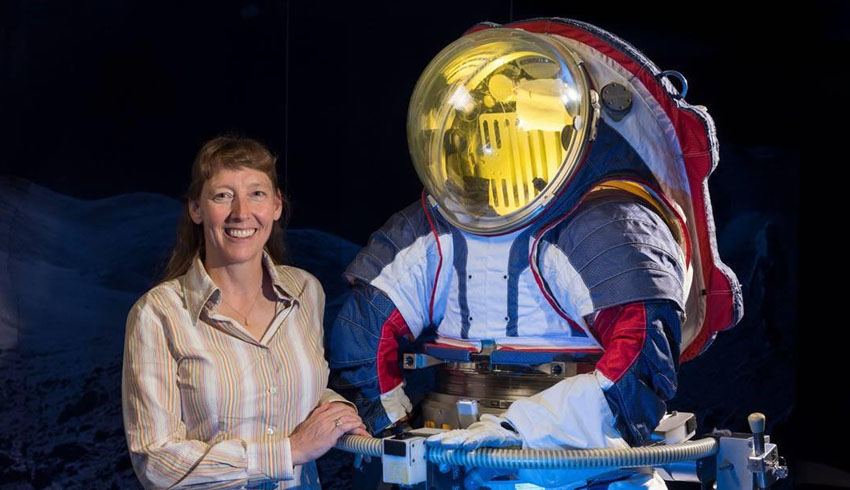Amy Ross, an advanced spacesuit designer at NASA's Johnson Space Center in Houston, is developing new suits for the moon and Mars – so Ross is eagerly awaiting this summer's launch of the Perseverance Mars rover, which will carry the first samples of spacesuit material ever sent to the Red Planet.
While the rover explores Jezero Crater, collecting rock and soil samples for future return to Earth, five small pieces of spacesuit material will be studied by an instrument aboard Perseverance called SHERLOC (Scanning Habitable Environments with Raman & Luminescence for Organics & Chemicals).
The materials, including a piece of helmet visor, are embedded alongside a fragment of a Martian meteorite in SHERLOC's calibration target. That's what scientists use to make sure an instrument's settings are correct, comparing readings on Mars to base-level readings they got on Earth.
Ross explained the testing process, "The materials we're poking at the most are meant to be on the outer layer of a suit, since these will be exposed to the most radiation. There's ortho-fabric, something we have a lot of experience using on the outside of spacesuits. That's three materials in one: It includes Nomex, a flame-resistant material found in firefighter outfits; Gore-Tex, which is waterproof but breathable; and Kevlar, which has been used in bulletproof vests.
"We are also testing a sample of Vectran on its own, which we currently use for the palms of spacesuit gloves. It's cut-resistant, which is useful on the International Space Station: Micrometeoroids strike handrails outside the station, creating pits with sharp edges that can cut gloves.
"We included a sample of Teflon, which we've used in spacesuits for a long time as part of astronaut glove gauntlets and the backs of gloves. Just like a nonstick pan, it's slippery, and it's harder to catch and tear a fabric if it's slick. We also included a sample of Teflon with a dust-resistant coating.
"Finally, there's a piece of polycarbonate, which we use for helmet bubbles and visors because it helps reduce ultraviolet light. A nice thing about it is it doesn't shatter. If impacted, it bends rather than breaks and still has good optical properties," Ross explained.
Expanding on this, Ross explained the details surrounding the new design for the next-generation of space suit, saying, "Spacesuit design depends on where you're going and what you're doing.
"The ISS suit is designed specifically for microgravity. If you go on a spacewalk, you're not really walking; you use your hands everywhere. Your lower torso is just used as a stable platform for your upper body. The suit is also exposed to two environmental sources of degradation: solar radiation and atomic oxygen. Atomic oxygen is different from the oxygen we breathe. It's very reactive and can degrade spacesuit materials."
Ross explained the difference between space suits designed for lunar and Martian exploration, stating, "The moon doesn't have the atomic oxygen problem but is worse than Mars in terms of radiation. You're pretty close to the sun and have no atmosphere to scatter the ultraviolet radiation like you do on Mars. The moon is a big testbed for the Artemis program.
"The environments of the moon and Mars aren't exactly the same, but the durability challenges – materials exposed over long periods of time at low pressures in a dusty environment – are similar.
"On Mars, you're farther from the sun, and you have at least a little atmosphere to scatter the UV. But that's when the duration of exposure starts to get you. You have to plan on being exposed on the surface most of the time. Mars spacesuits will be more like ones we use for the moon and less like those for the ISS. I'm trying to make the moon suit as much like the Mars suit as possible."
Perseverance is a robotic scientist that weighs just under 1,043 kilograms. The rover's astrobiology mission will search for signs of past microbial life. It will characterise the planet's climate and geology, collect samples for future return to Earth, and pave the way for human exploration of the Red Planet.
No matter what day Perseverance launches during its 30 July-15 August launch window, it will land at Mars' Jezero Crater on 18 February 2021.
A division of Caltech, NASA's Jet Propulsion Laboratory manages the Mars 2020 Perseverance rover mission for the agency's Science Mission Directorate. The mission is part of a larger program that includes missions to the moon as a way to prepare for human exploration of the Red Planet.
Charged with returning astronauts to the moon by 2024, NASA will establish a sustained human presence on and around the moon by 2028 through NASA's Artemis lunar exploration plans.

